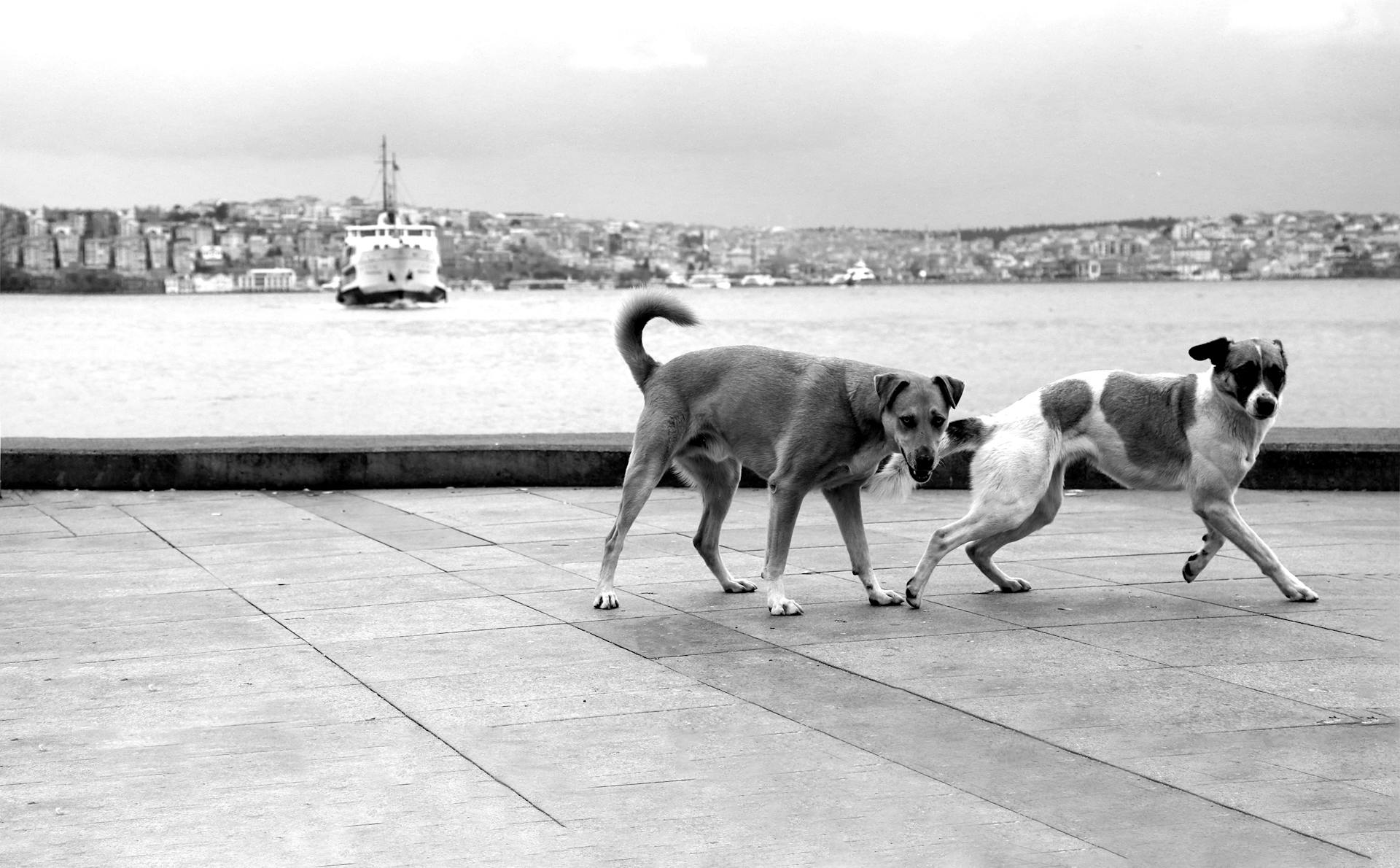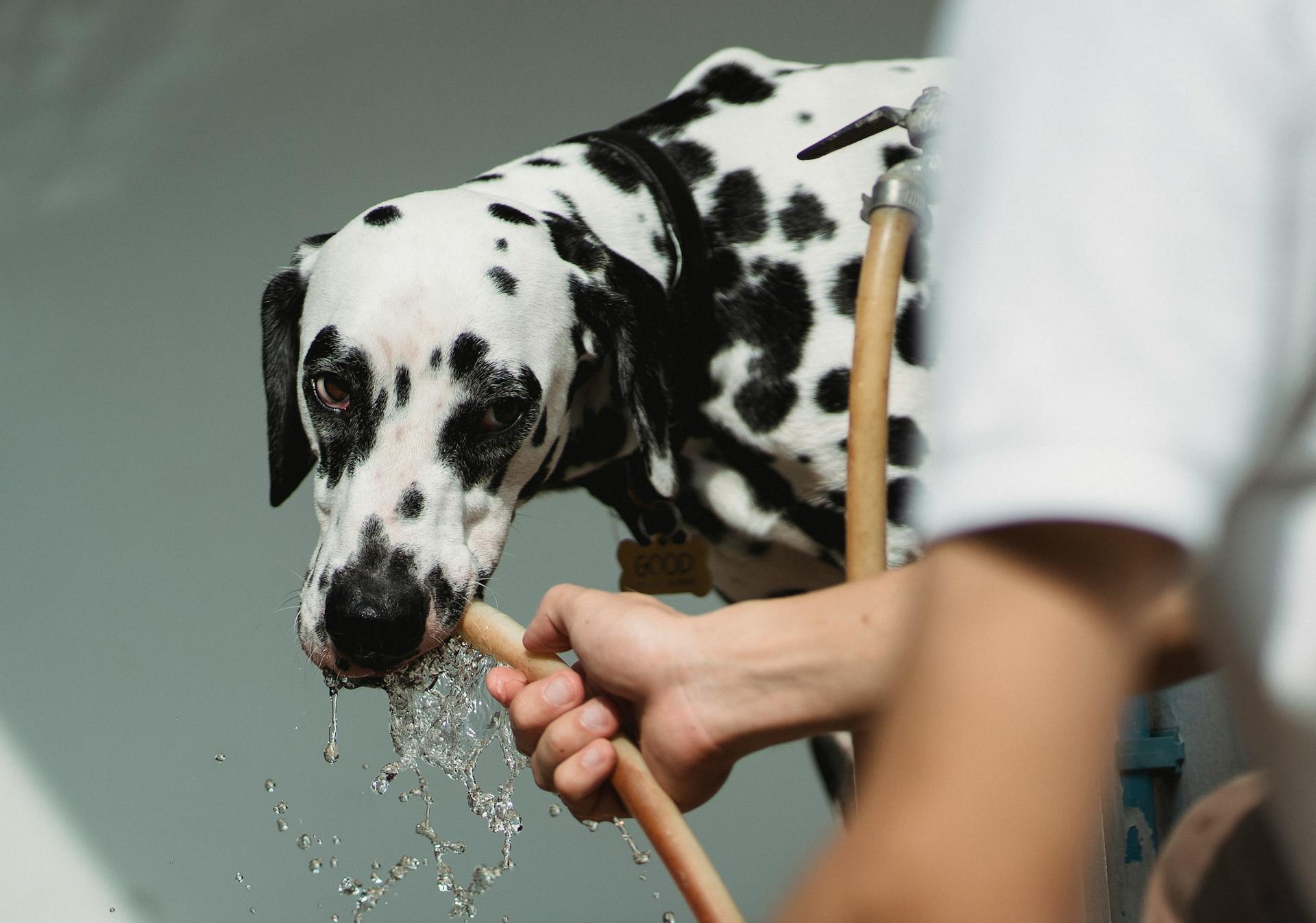
Dogs need to drink water regularly to stay hydrated, just like humans do. In fact, dogs can lose water quickly through panting, especially in hot weather.
A dog's water intake should match its activity level, so if your dog is highly active, it needs more water. For example, a study found that dogs that exercised for 30 minutes had a 20% increase in water intake.
Dogs can also lose water through vomiting or diarrhea, so it's essential to monitor their water intake closely if they have a sensitive stomach.
Hydration Importance
Hydration is crucial for your dog's overall well-being, making up a significant portion of their body. Proper hydration helps maintain proper organ function, aids digestion, and regulates body temperature.
Dogs generally require 0.5 to 1 ounce of water per pound of body weight per day, with a 50-pound dog needing approximately 50 to 100 ounces (or about 6 to 12 cups) of water daily. However, individual needs may vary.
Boasting nutrient absorption, water acts as a transportation system in your dog's body, helping to deliver important nutrients to each cell. This keeps your dog healthy and strong.
Proper hydration in dogs helps their bodies break down food into smaller pieces and produces helpful enzymes, promoting healthy digestion. Drinking enough water also helps dogs feel full and satisfied, making it easier for them to maintain a healthy weight.
A properly hydrated pup may have an easier time staying cool in hot weather, as dogs primarily cool their bodies through panting, which releases heat and water.
Dehydration Signs and Symptoms
Dehydration in dogs can be a serious issue, and it's essential to recognize the signs and symptoms to take prompt action.
Dry gums are a clear indicator of dehydration in dogs. They should be moist and shiny, but if they appear dry, sticky, or pale, it's a sign that your furry friend needs water.
Lethargy is another common symptom of dehydration in dogs. If your dog seems sluggish or reluctant to move, it could be a sign that they're not drinking enough water.
Here are some other signs of dehydration in dogs:
- Dry, sunken eyeballs
- Dry nose and mouth
- Loss of skin elasticity, where the skin takes longer to return to its normal position after being pinched
- Reduced appetite and panting
Dehydration Signs and Symptoms
Dehydration in dogs can be a serious issue, and it's essential to recognize the signs and symptoms early on.
If your dog's gums appear dry, sticky, or pale, it's a clear indication of dehydration. Their gums should be moist and pink, not dry and sticky.
Lethargy is another common sign of dehydration in dogs. If your furry friend is normally energetic and playful, but suddenly becomes sluggish and uninterested in playtime, it may be a sign that they're not getting enough water.
Sunken eyes are a telltale sign of dehydration. If your dog's eyes are normally bright and shiny, but now appear sunken and dull, it's a cause for concern.
Broaden your view: Why Do Dogs Stop Drinking Water
Dry nose and mouth are also signs of dehydration in dogs. If your dog's nose and mouth are normally moist, but now feel dry and cracked, it's a sign that they need to drink more water.
Here are some key signs of dehydration in dogs:
- Dry Gums
- Loss of Skin Elasticity
- Lethargy
- Sunken Eyes
- Reduced Appetite
- Panting and Increased Heart Rate
- Dry Nose
If you notice any of these signs, it's crucial to take immediate action to rehydrate your dog. Offer fresh, clean water and encourage them to drink. If your dog continues to show signs of dehydration or if you're concerned about their health, it's always best to consult your veterinarian for proper guidance and treatment.
May Be Sick
If your dog is sick from another underlying cause, it can affect their ability to drink enough water.
Their underlying condition might be causing them to lose their appetite, making it harder for them to stay hydrated.
If your dog has mobility issues, they may struggle to get to their water bowl, leading to dehydration.
Talk with your veterinarian to figure out why your dog is not drinking enough water and how you can help.
Why You Might Drink Less
You might drink less water sometimes due to a few common reasons. For example, if you're not feeling thirsty, it's a sign that your body is already getting enough water.
Some people might drink less water because they're eating foods with high water content, such as watermelon or cucumbers. Your body can get the water it needs from these foods, so you might not feel the need to drink as much.
Your dog might be drinking less water than usual for similar reasons, like eating foods with high water content or not feeling thirsty. Your dog's water needs can vary depending on its size, age, and activity level.
Your body might also be drinking less water if you're eating foods with high salt content. This can make you feel thirsty, but it's actually a sign that your body needs more water to balance out the salt.
Recommended read: Dogs Not Eating but Drinking Water
Increasing Water Intake
Increasing water intake in dogs is crucial for their overall health and well-being. Dogs need a significant portion of their bodies to be composed of water, making hydration essential.
To encourage your dog to drink more water, consider placing multiple water bowls in easily accessible areas around your home and yard. This way, your dog will always have fresh water available.
Dogs prefer clean and fresh-tasting water, so it's essential to change the water in their bowls daily and wash them thoroughly. This will prevent the buildup of residue or contaminants that might discourage your dog from drinking.
Some dogs are naturally drawn to running water, making a dog water fountain a great investment. The flowing water mimics a freshwater source, making it more appealing to your furry friend.
A general rule of thumb is to provide one ounce of water per pound of your dog's body weight. For example, a five-pound chihuahua will typically require 5 ounces of water a day, while a 70-pound lab will need around 70 ounces of water per day.
Incorporating moisture-rich foods into your dog's diet can also boost hydration. Wet dog food or adding water to dry kibble can help increase their overall water intake.
Here are some factors that can influence your dog's water intake:
Freezing low-sodium broth or water into ice cube trays can also provide a fun and hydrating treat for your dog.
Promoting Healthy Habits
Proper hydration is crucial for your dog's overall health and well-being. By implementing these simple tips, you can ensure that your dog stays hydrated and avoids potential health issues associated with dehydration.
Dogs generally require 0.5 to 1 ounce of water per pound of body weight per day, but individual needs may vary depending on factors such as exercise, weather conditions, and health conditions.
To encourage your dog to drink more water, try praising them every time they drink water, and consider giving them a treat. Keep water near and fresh, and bring it along on walks, especially on hot and sunny days.
Here are some tips to make fresh water easily accessible for your dog:
- Place multiple water bowls in easily accessible areas around your home and yard.
- Consider using spill-proof bowls, especially if you have an active or curious pup.
Remember to check your dog's water intake regularly and consult with a veterinarian if you notice persistent signs of dehydration.
Keep Fresh
Keeping fresh water available is crucial for your dog's health and well-being. Fresh water should be changed daily and bowls should be washed thoroughly to prevent residue buildup.

You can place multiple water bowls in easily accessible areas around your home and yard. Consider using spill-proof bowls for active or curious pups.
A 50-pound dog, for example, needs approximately 50 to 100 ounces (or about 6 to 12 cups) of water daily, but individual needs may vary.
Factors such as exercise, weather conditions, and health conditions can increase a dog's water intake requirements. It's essential to monitor your dog's water consumption and ensure fresh, clean water is readily available throughout the day.
To encourage your dog to drink more water, try these tips:
- Praise them every time they drink water, and consider giving them a treat.
- Keep water near and keep it fresh.
- Bring water along on walks and offer it often, especially on hot and sunny days.
- Add some flavor to the water, such as flavored ice cubes or low-sodium broth.
- Give them wet food or soak up dry food with a cup of water.
Bring with You
When you leave the house with your dog, remember to bring water and a portable water bowl with you. This is especially important when it's hot out.
You can find Nature's Logic bone broth for a little added hydration in their store locator.
A portable water bowl is a must-have for outdoor adventures with your furry friend.
Talk to Your Vet
If you're worried about your dog's hydration, chat with your veterinarian. They can provide personalized advice based on your dog's specific needs to help them increase their water intake.
Regular check-ups with your vet can also help identify potential health issues early on. This can prevent more serious problems from developing.
Your vet can offer tailored advice on exercise routines for your dog, taking into account their age, breed, and any health conditions they may have.
You might enjoy: Portuguese Water Dog Health Problems
Sources
- https://www.darwinspet.com/blog/how-to-get-my-dog-to-drink-more-water.html
- https://www.omnicalculator.com/biology/dog-water-intake
- https://www.petmd.com/dog/nutrition/evr_dg_the_importance_of_water
- https://www.1800petmeds.com/education/miscellaneous/why-is-my-dog-drinking-so-much.html
- https://natureslogic.com/blog/how-to-get-your-dog-to-drink-more-water/
Featured Images: pexels.com


